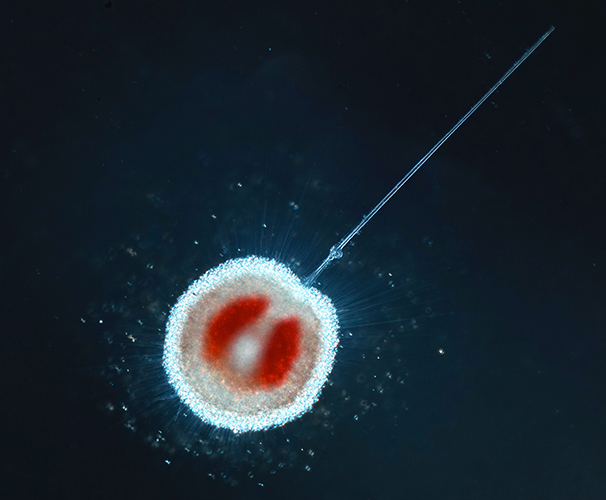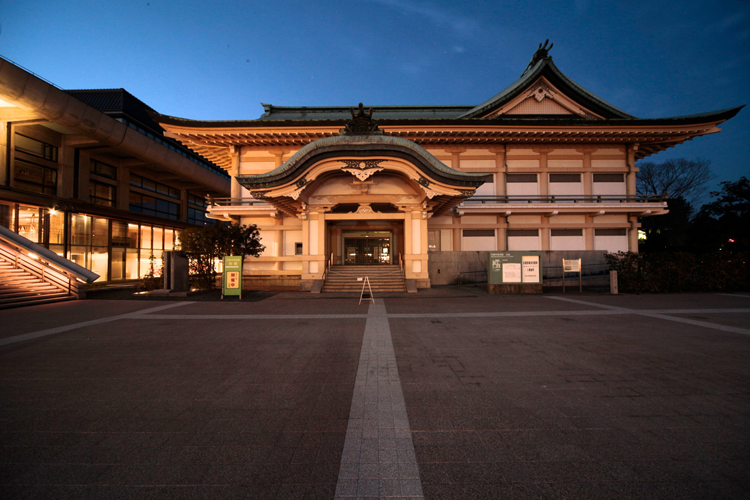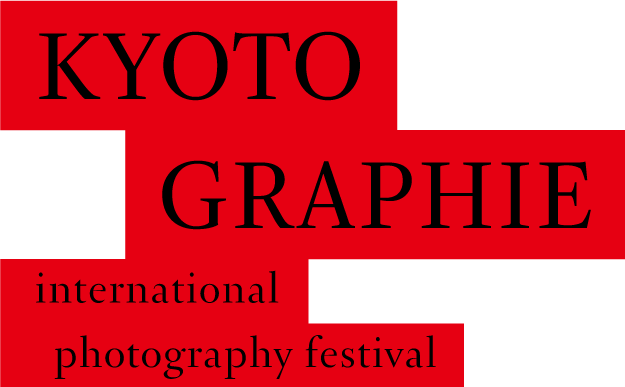9
Christian Sardet: images
Shiro Takatani: installation
Ryuichi Sakamoto: sound
PLANKTON: A Drifting World at the Origin of Life
supported by BMW
Kyoto Municipal Museum of Art Annex (2F)
Plankton are found in all the oceans of our planet;
they inhabit a world both beautiful and mysterious,
and are the source of all life
“Plankton” is the term used for all aquatic creatures that live adrift in the waters of our world. These mysterious life forms first came into being some 3.5 billion years ago. Most species are measurable only in microns, invisible to the naked eye, yet they form the base of our food chain. Not only do they generate half of all the oxygen on earth, they are also the ultimate source of most oil and natural gas resources.
Christian Sardet
Emeritus Research Director at the Observatoire Océanologique of Villefranche-sur-Mer (CNRS Centre National de la Recherche Scientifique and Paris University) Christian Sardet uses macro and micro-photography to capture images of plankton that show the beauty and multifaceted nature of these enigmatic creatures. As one of the co-founders and coordinator of the Tara Oceans expedition, Sardet himself is an energetic mariner who sails the seas of the world to photograph his subject. He is the creator, with the Macronauts – Noe Sardet and Sharif Mirshak – from Parafilms, Montreal of the “Plankton Chronicles” project.
Their documentaries, animated films and DVDs have won many prizes. Christian Sardet was awarded the “European Award for Communication in Life Sciences” from the European Molecular Biology Organization (EMBO, 2007). Kawade Shobo has published the Japanese edition of his book “Plankton – Wonders of the Drifting World”.
At KYOTOGRAPHIE, Sardet will exhibit photos and films of plankton, including new images recently taken in Shimoda, Japan, as well as photos of microplastic waste in the ocean.
Photography, Filming, and Editing support: The Macronauts / Noé Sardet & Sharif Marshak
Media authoring: Ken Furudate
Sound programing: Satoshi Hama

Christian Sardet, The radiolarian Spongodiscus biconcavus from Shimoda bay, 2015 © Christian Sardet and The Macronauts for KYOTOGRAPHIE / Plankton Chronicles Project
Shiro Takatani
Shiro Takatani, one of Japan’s best-known visual artists, has been involved in designing exhibition installations for KYOTOGRAPHIE.
Born in 1963 in Nara, Takatani became a co-founder of the internationally-known artist collective, Dumb Type, while still a student at Kyoto City University of Arts. He has been active in a wide range of fields−from visual arts to lighting, graphics, and set design. He began a parallel solo career in 1998, and through the utilization of some of Japan’s most advanced technologies, his multifarious work has gained wide recognition. As the first Japanese artist to participate in Cape Farewell, a “cultural response to climate change,” he ventured into the North Atlantic, showing his deep concern for this global issue.
Among Takatani’s performance works are Chroma (2012) and Life-Well (2013), a collaboration with Ryuichi Sakamoto and Mansai Nomura. In 2015, his work ST/LL was shown in France and Belgium to great acclaim, and in January 2016 it made a triumphal return to Biwako Hall in Japan. He has also held solo exhibitions, including Camera Lucida (2013, Tokyo Metropolitan Museum of Photography).
Ryuichi Sakamoto
Born in 1952, Ryuichi Sakamoto’s solo debut was in 1978 with Thousand Knives; later he became the co-founder of Yellow Magic Orchestra (YMO).
After the breakup of YMO, Sakamoto continued to pursue innovations in sound and music, earning international recognition, including an Academy Award in 1988 for his score for The Last Emperor. In the late 1990s, Sakamoto became active in environmental issues, and in 2007 he founded the initiative “more trees” to plant trees and help preserve forests. After the March 2011 earthquake/tsunami in northeastern Japan, Sakamoto became involved in a number of support organizations, including Life311, School Music Revival, and the Tohoku Youth Orchestra. He is also active in anti-nuclear efforts. Sakamoto was guest director of the 2014 Sapporo International Arts Festival (SIAF), showing the breadth and depth of trust and respect he enjoys from the art world for his knowledge of history, philosophy, and an open approach that transcends narrow definitions of music and art.
His best known works include “B-2 Unit” (1980), “Beauty” (1989), “Life” (1999), and “Three” (2012). Life-Well (2013) was a collaboration with Shiro Takatani.
Kyoto Municipal Museum of Art Annex (2F)
13 Okazaki Saishoji-cho, Sakyo-ku, Kyoto 606-8342
Tozai Line “Higashiyama” station 10 min on foot from exit 1
Keihan Line “Jingu-marutamachi” station 13 min on foot from exit 2
OPEN:9:00-17:00
CLOSED:Monday
¥800/ Student ¥600
[Related program]
Masterclass : Micro-Macrophopography by Christian Sardet and the Macronauts 4/30 – 5/1 9:00-17:00

© 2016 Naoyuki Ogino

